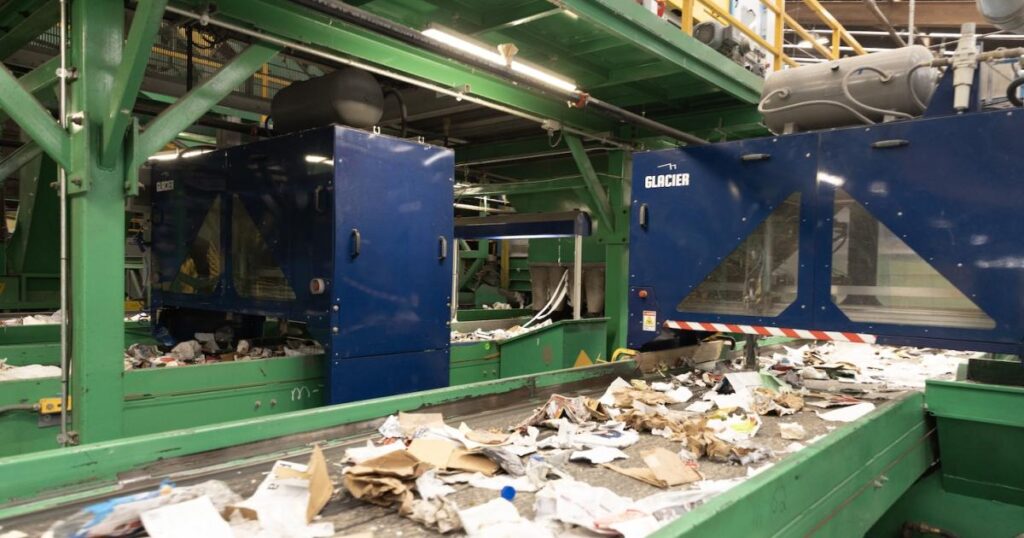Amazon is funding a recycling robots startup
4 min read
Amazon’s climate tech venture fund launched in 2020 with $2 billion to invest with companies developing potential solutions to its emissions reduction and environmental sustainability commitments. On Wednesday, it announced backing for its 25th venture, an early-stage, female-led San Francisco startup called Glacier that makes next-generation, AI-guided recycling robots.
The Climate Pledge Fund and New Enterprise Associates are notable funders for Glacier’s $7.7 million round, which brings the company’s total raised to $13 million. Other investors in this batch include AlleyCorp, Overture VC and VSC Ventures. Amazon’s participation marks the second investment for its Female Founder Initiative, a dedicated pool of $53 million.
Market revenue for recycling robots is forecast to reach more than $10 billion by 2030, as materials recovery facilities (MRFs) struggle with understaffing and the sheer volume of unique materials — nearly 300 million tons in 2018 for the U.S. alone — that they are expected to process.
“In order to build a future where new materials can be recycled at scale, we must test options to move these materials through the recycling system,” said Nick Ellis, principal of the Climate Pledge Fund. “Partnering with Glacier will enable us to test the role of novel AI and robotics-based recycling technologies so that we can identify and aggregate novel packaging materials that can ultimately be recycled and repurposed.”
Among the unique value propositions Glacier touts:
- The cost-effectiveness of its technology. While Glacier doesn’t disclose pricing, the co-founder said its robots cost substantially less than other technologies and facilities can see a return on their investment in under a year. Some recycling robots can cost up to $300,000;
- The robustness of its artificial intelligence software, which can identify more than 30 materials ranging from aluminum cans to toothpaste tubes; and
- The ability for its robots to squeeze into tight spaces other recycling robots are too big to fit.
Amazon is collecting data from a commercial pilot site at a Northern California MRF to determine how recycling recovery rates can be increased and how to sort out materials that can be returned to manufacturers for use against their waste reduction and circular economy targets, Ellis said.
Glacier plans to provide these sorts of insights across the recycling ecosystem — from product-makers to recycling facilities to materials recovery companies. “Glacier is a wonderful example of how we can be a catalytic investor, a catalytic customer and a convener,” he said.
Amazon’s industrial equipment interests
Glacier is one of several industrial hardware firms backed by the Climate Pledge Fund. Here are three other portfolio companies seeking to disrupt traditional processes:
- CMC Packaging Automation, which makes systems Amazon is using to custom-fit cardboard boxes, driving out waste and the need cushions made out of single-use plastic
- Redwood Materials, the EV battery recycling startup fronted by Tesla’s co-founder, JB Straubel
- Sunfire, a 14-year-old European firm developing electrolyzers for green hydrogen, which could play a role in Amazon’s warehouses and logistics network
Amazon hasn’t disclosed how much of the Climate Pledge Fund has been distributed or the exact amount it’s putting into Glacier, said Ellis. The fund’s best-known investment is its $1 billion infusion for Rivian, the electric van company making more than 100,000 vehicles for its delivery fleet.
When recycling robots make sense
AI-endowed robots and other automation technologies are seen as vital for helping MRFs build capacity and build revenue streams for selling collected material back to manufacturers eager to meet goals for using recycled content in their products and packaging.
They work by using sensors and software intelligence to visually identify materials of the same type and separate them from waste streams. Aside from Glacier, two companies angling to play a role are AMP and TOMRA.
Aside from selling its technology to MRFs, Glacier anticipates providing manufacturers with information that can be used for adapting product design and packaging characteristics — with a view to increasing recycling rates, said co-founder Rebecca Hu.
Up to 80 percent of residential items that could be recycled never make their way into recycling systems, according to Glacier. As just one example, the U.S. recovery rate for plastic is estimated at 5-6 percent annually. While many companies are touting their intent to put recycled content back into their products, the reality is that the system isn’t processing enough to meet that demand cost-effectively.
Recycling facilities are considering robots in places where it’s difficult to hire skilled workers and “where it’s more difficult for sorters to perform the task,” said Miriam Holsinger, co-president of Eureka Recycling, a nonprofit recycling operation in Minneapolis.
Cost has been an issue for adoption of recycling robots, Holsinger said, pointing both to the capital investment and to other considerations such as the need to install companion air compressors and train staff to handle maintenance of the more complicated equipment. Robots could also require MRFs to re-architect conveyors and collection chute locations, Holsinger said.
“That said, they show promise, especially where people aren’t able to handle the job,” she said.





